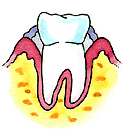
Gum Disease Prevention
Gum disease is a common dental problem that in most cases can be easily prevented. Unfortunately, as proved by epidemiological studies, the majority of the population appears to have gum disease problems because they fail to follow the necessary preventive measures. Advanced gum disease (periodontitis) is the major cause of tooth loss.
How to Prevent Gingivitis & Periodontitis
Prevention of gum disease can be achieved by eliminating the causative factors that lead to gum infections and periodontal disease. Simple measures that can help prevent gingivitis & periodontitis include:
Control of dental plaque
Bacterial plaque is considered as the main cause of gum inflammation that leads to gum disease. Prevention and treatment of gum disease is not possible if dental plaque is not under control. This can be achieved by:
- Tooth brushing – Regular tooth brushing is the best way to remove dental plaque from the surface of teeth.
- Brush your teeth at least twice a day and if possible after each meal.
- Learn how to brush – ask your dentist to demonstrate the correct way of brushing teeth to achieve effective removal of dental plaque
- Use a soft toothbrush to minimize the risk of gum recession. Change it every 3 months.
- Avoid vigorous brushing to prevent damage of the gingival tissues
- Flossing – Use dental floss at least once a day to remove bacteria and food debris from areas that tooth brush can not reach. Toothbrushing alone is not enough for removing dental plaque from interdental spaces (between teeth).
- Antimicrobial toothpastes – some toothpastes contain special antimicrobial ingredients such as triclosan or zinc that can remain in the mouth and delay the growth of bacterial plaque for several hours after brushing.
- Antimicrobial mouth rinses – an over the counter mouthwash containing antimicrobial agents can help in the prevention of gum disease as a supplement of toothbrushing and flossing. Prescription mouthwashes that contain chlorexidine should not be used for prevention but only for short term treatment of gum disease
- Regular dental visits – symptoms of gum disease are often not recognized or ignored until the condition has developed into severe periodontal disease.
Regular dental visits every 6 months are important for the early diagnosis of gum disease. Professional cleaning removes dental tartar from teeth reducing the risk of gum recession.
Your dentist can identify any initial signs of gum disease before it starts to permanently damage the gums and bone. Many general dentists include Periodontal Screening and Recording (PSR) that involves measuring of periodontal pockets as part of a regular dental examination. Patients who have had any form of periodontal disease may need to visit their dentist or periodontist more frequently.
Self examination
Check your gums regularly for any signs of gum diseases. Visit your dentist if you notice gum bleeding, a change in the color or texture of the gums, gum swelling or any other symptom of periodontal disease.
No Smoking
Except of all other known health problems caused by smoking, it is also considered as a major cause of gum disease. Smokers have much higher risk not only for periodontal disease and tooth loss but also for oral cancer.
Healthy diet
A well balanced diet rich in vitamins can help in the prevention of gum disease. Avoid excessive sugar consumption that can promote the growth of dental plaque bacteria. Do not eat sweets between meals. Healthy diet can make it easier for the body to fight an infection.
Importance of Gum Disease Prevention
Periodontal disease can cause permanent damage to the gingival tissues and jaw bone that can lead to tooth loss. Treatment can require expensive periodontal surgery procedures. Dental implants, bridges or dentures will be needed if tooth loss has occurred. Following the instructions for the prevention of gum disease can help to stop gingivitis and periodontitis before they develop.

